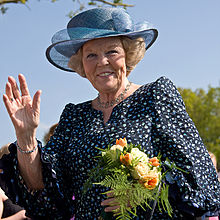Lippe-Biesterfeld
| House of Lippe-Biesterfeld | |
|---|---|
 Coat of arms of the House of Lippe (simple variant),[1] later also used by Lippe-Biesterfeld[2] | |
| Parent house | House of Lippe |
| Country | Biesterfeld, Lippe, Germany, Netherlands |
| Founded | ca. 1625 |
| Founder | Jobst Herman |
| Current head | Armin, Prince of Lippe (also Head of the House of Lippe) |
| Titles |
|
Lippe-Biesterfeld was a cadet line of the House of Lippe between 1762 and 1905, a morganatic title till 1916, and a title of the Dutch Royal House created in 1937.
History
The branch of Lippe-Biesterfeld was founded by Jobst Herman (1625-1678), youngest son of Simon VII of Lippe-Detmold. From the line Lippe-Biesterfeld later the branch Lippe-Weissenfeld was separated. Both the Counties Lippe-Biesterfeld and Lippe-Weissenfeld were ceded and sold to the princely line of Lippe(-Detmold) on 24 May 1762.[3] The Head of the Lippe-Biesterfeld family was given the style Illustrious Highness (German: Erlaucht) at Detmold on 27 August and 1 October 1844.[3]
When in 1895 the mentally ill Prince Alexander ascended the throne of the Principality of Lippe, Prince Adolf of Schaumburg-Lippe was appointed to act as regent of Lippe, this according to a then secret kept decree of the predecessor Prince Woldemar. Alexander was the last male of the Lippe-Detmold line, the next senior lines of the House of Lippe were the Counts of Lippe-Biesterfeld, followed by the Counts of Lippe-Weissenfeld, and then by the most junior line the Princes of Schaumburg-Lippe.
Shortly after becoming a member state of the German Empire in 1871, the Lippe-Detmold line died out on 20 July 1895. This resulted in an inheritance dispute between the neighboring principality of Schaumburg-Lippe and the Lippe-Biesterfeld line. The dispute was resolved by the Imperial Court in Leipzig in 1905, with the lands passing to the Lippe-Biesterfeld line who, until this point, had no territorial sovereignty. Since then the Counts of Lippe-Biesterfeld were the Princes of Lippe.
The current head of the Lippe-Biesterfeld family is Armin, Prince of Lippe (born 18 August 1924), who is also the Head of the whole House of Lippe. Armin is the son of Prince Leopold IV (1871–1949), and a first cousin of Prince Bernhard of the Netherlands (1911–2004), the prince consort of Queen Juliana of the Netherlands (1909–2004).
1627-1762: Lords of Lippe-Biesterfeld
- Jobst Herman (1625-1678)
- Rudolf Ferdinand (1761-1736)
- Friedrich (1706–1781), raised to Count of Lippe-Biesterfeld in 1762
1762-1905: Counts of Lippe-Biesterfeld
- Friedrich, 1st Count of Lippe-Biesterfeld (1706–1781)
- Karl, 2nd Count of Lippe-Biesterfeld (1735–1810)
- Ernst, 3rd Count of Lippe-Biesterfeld (1777–1840)
- Julius, 4th Count of Lippe-Biesterfeld (1812–1884)
- Ernst, 5th Count of Lippe-Biesterfeld (1842–1904)
- Leopold, 6th Count of Lippe-Biesterfeld (1871–1949)
On 25 October 1905 Count Leopold became the reigning Prince of Lippe.
1909-1916: Morganatic title

On 8 February 1909, the title Countess of Biesterfeld (not related to the previous title Count of Lippe-Biesterfeld) was created for Armgard of Sierstorpff-Cramm (1883–1971) and her descendants. Armgard was the wife of Prince Bernhard of Lippe-Biesterfeld (1872–1934), the brother of Prince Leopold IV. On 24 February 1916, Armgard and her two sons Bernhard (1911–2004) and Aschwin (1914–1988) were created Prince(ss) of Lippe-Biesterfeld with the style Serene Highness.[4] However, they did not belong to the main House of Lippe, since the marriage between Bernhard and Armgard was a morganatic marriage.
1937-present: Title of the Dutch Royal House
By royal decree of 6 January 1937, the titles Prince of the Netherlands and Prince of Lippe-Biesterfeld, with the style Royal Highness, were created in the Kingdom of the Netherlands for Prince Bernhard and his descendants.[5] The Lippe-Biesterfeld title hereby became also a Dutch one. On 7 January 1937, Bernhard married Princess Juliana of the Netherlands (who later was the Queen regnant of the Netherlands between 1948 and 1980). From this marriage four daughters were born who all hold the title Princess of Lippe-Biesterfeld:
- Beatrix (born 1938) - since 1980, the current Queen of the Netherlands.
- Irene (born 1939)
- Margriet (born 1943)
- Christina (born 1947)
Since the title is only inheritable in male line, with them the title will become extinct.
By royal decree of 26 May 1998, the descendants of Prince Maurits of Orange-Nassau, van Vollenhoven (born 1968), eldest son of Princess Margriet, all have the newly created surname van Lippe-Biesterfeld van Vollenhoven.[6] This is a non-aristocratic branch of the family Van Vollenhoven.
See also
References
- ^ House of Lippe - European Heraldry website
- ^ Wappen und Handbuch des in Schlesien (einschliesslich der Oberlausitz) landgesessenen Adels. Alfred Freiherrn von Krane-Goerlitz (1901 - 1904)
- ^ a b Almanach de Gotha (141st ed.). Justus Perthes. 1904. p. 53.
- ^ Almanach de Gotha (179th ed.). Justus Perthes. 1942. p. 79.
- ^ Decree about the titles and names of Prince Bernhard after his marriage with Princess Juliana - Website with Legislation concerning the Royal House of the Netherlands (Dutch)
- ^ Royal decree about the surname of the children of Prince Maurits of Orange-Nassau, van Vollenhoven - official legal website of the Dutch government
